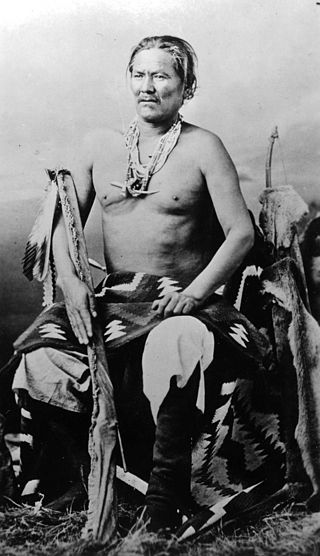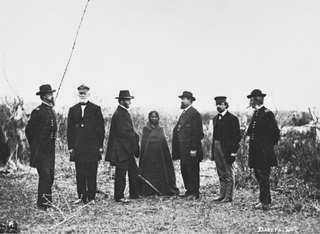
The Hopi are Native Americans who primarily live in northeastern Arizona. The majority are enrolled in the Hopi Tribe of Arizona and live on the Hopi Reservation in northeastern Arizona; however, some Hopi people are enrolled in the Colorado River Indian Tribes of the Colorado River Indian Reservation at the border of Arizona and California.

The Long Walk of the Navajo, also called the Long Walk to Bosque Redondo, was the deportation and ethnic cleansing of the Navajo people by the United States federal government and the United States army. Navajos were forced to walk from their land in western New Mexico Territory to Bosque Redondo in eastern New Mexico. Some 53 different forced marches occurred between August 1864 and the end of 1866. In total, 10,000 Navajos and 500 Mescalero Apache were forced to the internment camp in Bosque Redondo. During the forced march and internment, up to 3,500 people died from starvation and disease over a four-year period. In 1868, the Navajo were allowed to return to their ancestral homeland following the Treaty of Bosque Redondo. Some anthropologists state that the "collective trauma of the Long Walk ... is critical to contemporary Navajos' sense of identity as a people".

The term Navajo Wars covers at least three distinct periods of conflict in the American West: the Navajo against the Spanish ; the Navajo against the Mexican government ; and the Navajo against the United States. These conflicts ranged from small-scale raiding to large expeditions mounted by governments into territory controlled by the Navajo. The Navajo Wars also encompass the widespread raiding that took place throughout the period; the Navajo raided other tribes and nearby settlements, who in return raided into Navajo territory, creating a cycle of raiding that perpetuated the conflict.
Philip Johnston was an American civil engineer who is credited with proposing the idea of using the Navajo language as a Navajo code to be used in the Pacific Theater during World War II.

Chief Manuelito or Hastiin Chʼil Haajiní was one of the principal headmen of the Diné people before, during and after the Long Walk Period. Manuelito is the diminutive form of the name Manuel, the Iberian variant of the name Immanuel; Manuelito translates to Little Immanuel. He was born to the Bit'ahnii or ″Folded Arms People Clan″, near the Bears Ears in southeastern Utah about 1818. As many Navajo, he was known by different names depending upon context. He was Ashkii Diyinii, Dahaana Baadaané, Hastiin Ch'ilhaajinii and as Nabááh Jiłtʼaa to other Diné, and non-Navajo nicknamed him "Bullet Hole".
The Fifth World in the context of creation myths describes the present world as interpreted by several indigenous groups in the USA and Mexico. The central theme of the myth holds that there were four other cycles of creation and destruction that preceded the Fifth World. The creation story is taken largely from the mythological, cosmological, and eschatological beliefs and traditions of earlier Mesoamerican cultures.

The Navajo or Diné, are a Native American people of the Southwestern United States.
Red Raven is the name of three separate fictional characters appearing in American comic books published by Marvel Comics. These characters are the original Red Raven, a flying superhero, who appeared in print once in 1940, then not again until 1968, and occasionally since then; the second Red Raven, named Dania, who is a flying superhero and daughter of the original Red Raven, who first appeared in print in 1992, and occasionally since then; and Redford Raven, a Wild West villain who owned a set of medicine-enchanted wings, was also called Red Raven, and has appeared in print three times, in 1964, 1985, and 1987.

A hogan is the primary, traditional dwelling of the Navajo people. Other traditional structures include the summer shelter, the underground home, and the sweat house. A hogan can be round, cone-shaped, multi-sided, or square; with or without internal posts; with walls and roof of timber, packed earth, and stone in varying amounts, and a bark roof for a summer house. The door traditionally faced east to welcome the rising sun, believed to bring good fortune.

As many as 25,000 Native Americans in World War II fought actively: 21,767 in the Army, 1,910 in the Navy, 874 in the Marines, 121 in the Coast Guard, and several hundred Native American women as nurses. These figures included over one-third of all able-bodied Native American men aged 18 to 50, and even included as high as seventy percent of the population of some tribes. The first Native American to be killed in WWII was Henry E. Nolatubby from Oklahoma. He was part of the Marine Detachment serving on the USS Arizona and went down with the ship on December 7, 1941. Unlike African Americans or Asian Americans, Native Americans did not serve in segregated units and served alongside white Americans.
In Navajo culture, a skin-walker is a type of harmful witch who has the ability to turn into, possess, or disguise themselves as an animal. The term is never used for healers.

The Wheelwright Museum of the American Indian is a museum devoted to Native American arts. It is located in Santa Fe, New Mexico and was founded in 1937 by Mary Cabot Wheelwright, who came from Boston, and Hastiin Klah, a Navajo singer and medicine man.

Peter MacDonald is a Native American politician and the only four term Chairman of the Navajo Nation. MacDonald was born in Arizona, U.S. and served the U.S. Marine Corps in World War II as a Navajo Code Talker. He was first elected Navajo Tribal Chairman in 1970.
Jerry ClasChee Begay Sr. was an American World War II veteran and a member of the Navajo Code Talkers.
Jeff King was a US Army scout from 1891 to 1911, and went on to become a highly respected hataałii.

The Indian Peace Commission was a group formed by an act of Congress on July 20, 1867 "to establish peace with certain hostile Indian tribes." It was composed of four civilians and three, later four, military leaders. Throughout 1867 and 1868, they negotiated with a number of tribes, including the Comanche, Kiowa, Arapaho, Kiowa-Apache, Cheyenne, Lakota, Navajo, Snake, Sioux, and Bannock. The treaties that resulted were designed to move the tribes to reservations, to "civilize" and assimilate these native peoples, and transition their societies from a nomadic to an agricultural existence.

Joe Morris Sr. was an American World War II United States Marine veteran and Navajo code talker.
Navajo medicine covers a range of traditional healing practices of the Indigenous American Navajo people. It dates back thousands of years as many Navajo people have relied on traditional medicinal practices as their primary source of healing. However, modern day residents within the Navajo Nation have incorporated contemporary medicine into their society with the establishment of Western hospitals and clinics on the reservation over the last century.

Frank Chee Willeto was an American politician and Navajo code talker during World War II. Willeto served as the vice president of the Navajo Nation under President Milton Bluehouse, Sr. from his appointment in August 1998 until January 1999, when the Begaye administration took office.











